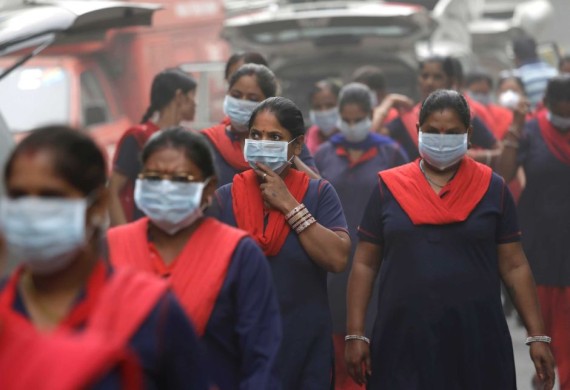
COVID-19 Caused Astonishing Drop in Women's Employment Rate in India
By: Navyasri, Content Writer, Women Entrepreneur | Thursday, 5 August 2021
In 2017, India achieved two significant milestones. First, it earned the title of the world's fastest-growing major economy, with growth rates consistently exceeding 7 percent since 2011-12. The second milestone was a more sobering one: in 2017, India's female labour force participation and employment levels fell to their lowest levels since independence.
In India, less than a quarter of women have entered the labour force, and only one-fifth are employed. According to a 2017 World Bank report, India has one of the lowest rates of female labour force participation in the world, with only parts of the Arab world having lower rates than India.
These trends have been exacerbated by COVID-19. The initial lockdown disproportionately affected women. Between March and April 2020, 26.6 percent of the female workforce left the labour force, compared to 13.4 percent of men.
Female labour force participation in India fell to 16.1 percent during the July-September 2020 quarter, the lowest among major economies, according to a government report, reflecting the impact of a pandemic and a widening job crisis.
According to the report, the percentage of women in the force fell to a record low of 15.5 percent during the April-June 2020 quarter, when India imposed a strict lockdown to combat the spread of the COVID19 virus.
According to World Bank estimates, India has one of the world's lowest rates of female labour force participation. Less than one-third of women–defined as those aged 15 and up in the report – are employed or actively looking for work.
According to World Bank estimates, the female labour participation rate in India fell to 20.3 percent in 2019 from more than 26 percent in 2005, compared to 30.5 percent in neighbouring countries Bangladesh and 33.7 percent in Sri Lanka.
Between 1977 and 2017, India's GDP contribution from services (39 percent to 53 percent) and industry (33 percent to 27 percent) increased. Rural men's employment in agriculture fell from 80.6 percent to 53.2 percent, while rural women's employment fell from 88.1 percent to 71.7 percent (NSSO data).
The majority of women employed in India work in low-skilled jobs such as farm and factory labour, as well as domestic help, all of which have been severely impacted by the pandemic.
During the three months that ended in September 2020, the latest quarter for which data was released, the unemployment rate among women reached 15.8 percent, compared to 12.6 percent among male workers.
Most economic activities in the country have resumed after state governments relaxed pandemic restrictions in response to a drop in coronavirus infections from May peaks. According to government officials, this is likely to help create more jobs for all workers.
Asia's third-largest economy, which shrank 7.3 percent in the fiscal year ending in March, the worst recession in seven decades, is expected to grow at an annual rate of 8-9 percent in the current fiscal year.
The July unemployment rate in India fell to 6.95 percent from 9.17 percent in June, according to data from the Centre for Monitoring Indian Economy (CMIE) released on Monday.
Many private economists have warned that the slow pace of vaccination and a slump in consumer demand could harm growth prospects, and that the economy will be unlikely to reach pre-Covid levels before March 2022.
Asia's third-largest economy, which shrank 7.3 percent in the fiscal year ending in March, the worst recession in seven decades, is expected to grow at an annual rate of 8-9 percent in the current fiscal year.
The need for a "second income" has decreased as household incomes have increased, particularly over the last three decades. As a result, as a sign of prosperity, families withdrew women from labour. This “income effect” can account for approximately 9% of the total decline in female labour force participation from 2005 to 2010.
Unpaid care work is still primarily a female responsibility, with women spending an average of five hours per day on domestic work compared to 30 minutes for men (NSSO, 2019). Women have extremely limited mobility, with only 54% being able to go to a nearby market on their own (NFHS, 2015-16).
Women frequently forego wages, career advancement, and educational opportunities in order to meet family responsibilities, safety concerns, and other constraints.
The COVID-19 pandemic has come as a shock in this context, resulting in massive job losses for women, particularly informal workers, and a slower recovery of women-led microbusinesses. It has also increased domestic work, widened gender digital divides, disrupted girls' education, and put the lives of millions of female health workers in jeopardy.
To chart a gender-sensitive socioeconomic recovery post-COVID-19, the government, private sector, media, and social sector must collaborate to improve working conditions, reduce wage disparities, expand opportunities for women across sectors, and shift mindsets.
State governments may set gender-based employment goals for urban public works projects. Wage subsidies may be considered by the federal or state governments to encourage the hiring of women in micro, small, and medium-sized businesses. Governments could mandate or incentivize gender targets in skill training institutions.
Corporates should keep track of the proportion of women at various levels of seniority in various job roles. Firms and non-governmental organisations (NGOs) should collaborate to bridge the digital gender divide by providing free mobile phones and laptops to girls from disadvantaged communities, as well as long-term training.
Most Viewed
- 1 Women's Health Startup HerMD Closing Doors Amid Industry Challenges
- 2 5 Famous Women in Indian Armed Forces
- 3 Saudi Women No longer Require Male Permission for Clothing Choices, says Prince MbS
- 4 Kolkata Medtech Startup Innovodigm Raises Rs 5.5 Crore Seed Funding Led by IAN Group
- 5 Yamunanagar's Kashish Kalra Honoured after Securing 111th Rank in UPSC Civil Services Exam
- 6 Madurai Appoints Its First Woman Corporation Head
- 7 IAS Vijayalakshmi Bidari Appointed as the new Nagpur Divisional Commissioner
- 8 American Entrepreneur Lucy Guo Overtakes T Swift to become Youngest Female Billionaire
- 9 ICC Women's World Cup 2025 Trophy Showcased at Indore's Holkar Stadium
- 10 Aparna Saxena's Beauty Venture AntiNorm Launches in India
- 11 Vidya Nataraj Co-Founded BlueStone Jewellery & Lifestyle files IPO
- 12 5 Women Freedom Fighters of India
- 13 Dr. G Krishnapriya appointed as CEO for Trichy
- 14 M3M & Sirona Partner to Introduce Menstrual Hygiene Vending Machines in 15 Locations
- 15 Punjab Govt launches SHE Cohort 3.0 Supporting Tech-led Women Startups
- 16 Indian origin Lawyer, Sweena Pannu appointed as the US New Superior Court Judge
- 17 The Aurora Tech Award recognizes 4 Indian Women-led Startups
- 18 Kerala's Republic Day parade featured an all-female tableau
- 19 Manisha Kabbur Becomes Karnataka's First Woman International Karate Coach
- 20 Director K. S. Ravikumar's Daughter Maalica Ravikumar Launches Life Coaching Company 'Evergrowth Academy' for Women
- 21 Leezu's Raises Pre-Seed Funding to Accelerate Growth in Sexual Wellness Industry
- 22 Sattu: Super-easy summer drink for PCOS gut healing
- 23 Swathi Nelabhatla creates Sitha App, India's First Women-Exclusive Gig Platform
- 24 7 Timeless Female Kathak Dancers & their Iconic Legacies
- 25 Meet 7 Iconic Women Architects of Modern India & their Most Impactful Work
- 26 This Woman-led Insuretech Startup is Helping Bridge the Education Financing Gap in India
- 27 Women Leaders Share Lessons Learnt from India Women's WC Win
- 28 5 Enterprising Women Founders Powering Singapore's Tech & Innovation Landscape
- 29 4 Women. 4 Stories. One Vision for Smarter, Stronger Healthcare
- 30 Global Gender Gap Narrows to 68.8%, But Full Equality 123 Years Away: WEF Report 2025
- 31 Changemakers: 7 Women Entrepreneurs Taking the Make in India Movement Forward
- 32 Meet Lucy Guo, The Youngest Self-Made Female Billionaire Disrupting Tech
- 33 How Women are Driving India's Festive Online Shopping Surge






